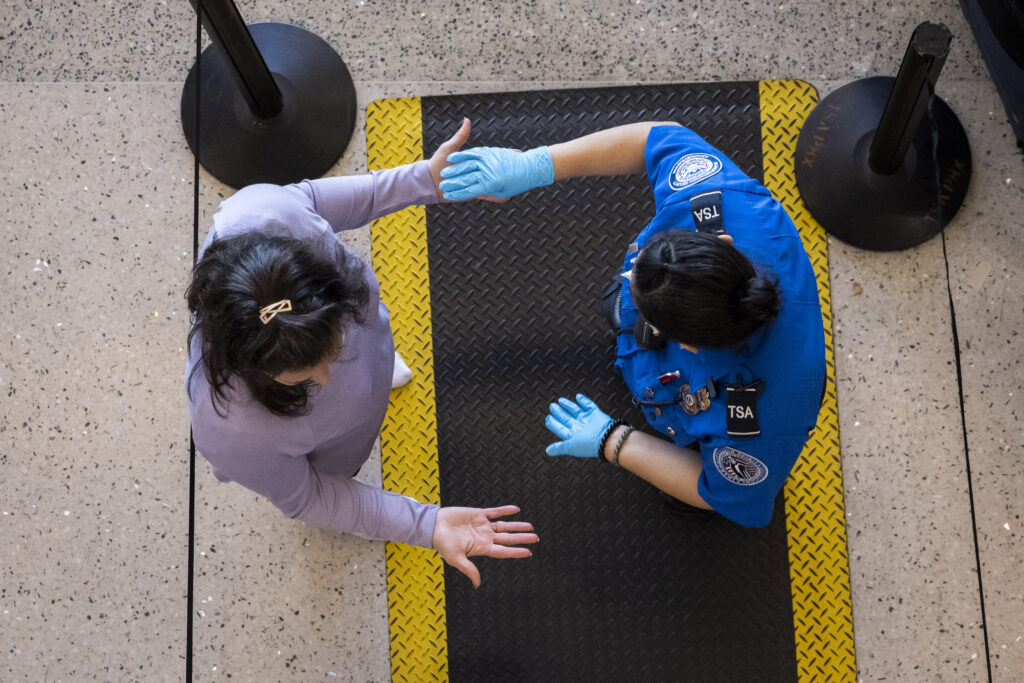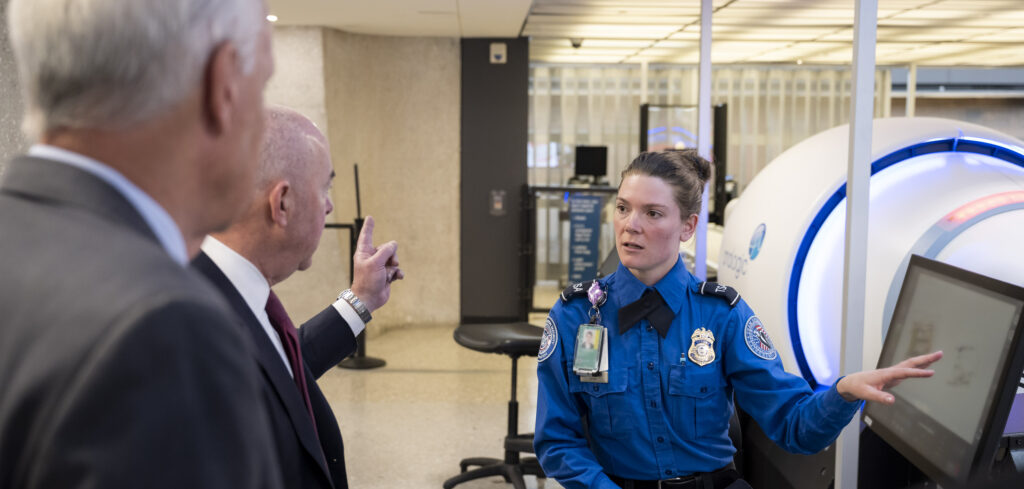The US Government Accountability Office (GAO) says the Transportation Security Administration (TSA) has had issues with ensuring that its screening technologies consistently meet detection standards after being put into service.
GAO first reported in 2019 that the performance of passenger screening technologies deployed by TSA can degrade over time. At a hearing on October 19, 2023, where GAO’s findings and the current status of TSA passenger screening were discussed, House Homeland Security Subcommittee on Transportation and Maritime Security Chairman Carlos Gimenez also voiced his concerns that TSA has not appropriately prioritized the development and deployment of new technological systems within its passenger screening process.
“Earlier this year, [TSA] Administrator David Pekoske informed this subcommittee that the agency projects it will fully integrate the new computed tomography, or CT, machines used to screen carry-on luggage and the second-generation Credential Authentication Technology, or CAT-2, systems used for passenger identify verification by fiscal years 2042 and 2049 respectively,” Gimenez said. “These timelines mean that the agency will take over 20 years to adopt the technologies it needs today. Frankly, this is too slow. I am concerned that TSA has not adequately prioritized accelerating this timeline.”
Gimenez said TSA is also forgoing opportunities to invest in other technologies like ‘detection at range’ that would further increase TSA’s capabilities at passenger checkpoints and decrease the need for screening procedures like physical pat-downs that some consider to be invasive.
The hearing also heard from House Homeland Security Subcommittee on Transportation and Maritime Security ranking member Shri Thanedar, who called on Congress to provide sustained funding for checkpoint security technologies. Thanedar is a co-sponsor of the bill known as the Fund the TSA Act, which, among other measures, would set aside US$250m for checkpoint security technologies such as computed tomography machines for each of the next five years. The act, which was introduced in May, would fund security improvements at US airports by ending the diversion of portions of Passenger Security Fee collections to the general treasury and return all fee collections to TSA for security operations. It would also increase the Passenger Security Fee by US$2 per one-way trip.
Certification and calibration
TSA currently uses two processes—certification and calibration—to ensure screening technologies are operating as intended. The certification process is designed to ensure that new technologies meet detection requirements before they are procured and deployed to airports. TSA officials have previously told GAO that daily calibration helps ensure that the technologies are at least minimally operational while in use at airports. However, in its October 2023 update, GAO maintains that while certification and calibration serve important purposes in the acquisition and operation of screening technologies, these processes do not ensure that TSA screening technologies continue to meet detection requirements after they have been deployed.
There are of course challenges in designing a process to ensure that screening technologies continue to meet detection requirements after deployment. For example, it is not feasible to conduct live explosives testing in airports.

TSA Review Policy
Back in 2019, as part of its first report on the issue, GAO recommended that TSA develop a process to ensure that screening technologies continue to meet detection requirements after deployment to commercial airports and implement that process. As of October 2023, the watchdog says TSA has only partially addressed this requirement.
In April 2020, TSA issued the TSA Post Implementation Review (PIR) and Periodic Review Policy, which calls for TSA to develop and conduct a PIR, or roadmap, for how TSA will assess technology performance for each screening technology after initial deployment. The policy identifies a specific timeframe for conducting this review and requires that TSA determine system performance relative to effectiveness and suitability as part of the review. Additionally, the policy calls for TSA to conduct periodic reviews of each technology after the Post-Implementation Review, to assess system performance over time and examine whether functionality changes need to be made.
However, GAO has now found that timeframes and other requirements for conducting periodic reviews are less clear. For example, the policy does not specify system performance requirements relative to effectiveness and suitability for periodic reviews.
It is worth noting that in May 2023, TSA stated that it intends to adjust its policy on Periodic Reviews to include the same type of requirements as PIRs. According to TSA, such adjustments will include “a general timeframe for conducting periodic reviews that allows for management team judgment based on specific needs and the assessment of system performance requirements relative to effectiveness and suitability”. TSA estimates that this update will be completed by December 31, 2023.
At the October 19 hearing, Mario Wilson, Assistant Administrator for Acquisition Program Management, welcomed GAO’s findings and said TSA has begun to conduct and report on the results of post-implementation and periodic reviews for selected technologies.
Indeed, GAO recently assessed TSA’s finalized and draft reports of the Post-Implementation and Periodic Reviews and found that the agency has made “notable progress” in implementing these policies. In particular, TSA leveraged the national standard for image quality testing of computed tomography systems to assess detection performance of the checked baggage screening systems without the use of explosives testing. The agency is also working to develop a similar image quality test for advanced imaging technology that would evaluate degradation of detection performance without the use of live explosives.
Speaking to Passenger Terminal Today, Steve Karoly, former Acting Assistant Administrator for the TSA Office of Requirements and Capabilities Analysis and now executive vice president at K2 Security Screening Group, said that as well as TSA, the Department of Homeland Security’s Science and Technology Directorate continually conducts research and development efforts to improve security effectiveness and efficiency throughout the lifecycle of TSA’s security equipment.
“Technology pilots and demonstrations, certification and qualification testing, of both algorithms (software) and equipment (hardware), are conducted, which eventually results in the deployment of approved software and hardware,” Karoly explained. “This process enables TSA to ensure that the security screening equipment located at airports across the nation meet the latest and greatest known threats.”
Technology updates reduce pat-downs
As part of its primary passenger screening at airport security checkpoints, TSA may use advanced imaging technology (AIT). Passengers who trigger an alarm on the advanced imaging technology machine may be required to undergo secondary screening, which could include a targeted pat-down and, in some cases, explosive trace detection screening.
Karoly’s colleague at K2 Security Screening Group, vice president Boyd Keith Jeffries, who was formerly the federal security director at Los Angeles International Airport, told Passenger Terminal Today that AIT has enabled improved screening for both TSA and passengers.
“The advanced image technology used in airports today allows security personnel to accurately identify potential metallic and non-metallic threats,” Jeffries said. “AIT enables security personnel to detect threats in real time, using algorithms that automatically flag suspicious areas on the person. This not only speeds up the screening process but also ensures a higher level of accuracy in identifying potential threats.”
GAO has found that AIT machines have historically alarmed more frequently on certain passengers, including transgender passengers, passengers who wear religious headwear, or passengers with certain hair types and styles.
Jeffries says that TSA has been working on improving the accuracy of the AIT equipment as well as ensuring they are gender neutral. “This has decreased the alarm rate and improved the passenger experience for the transgender traveler,” he said. “As for headwear, there are special screening procedures available to detect potential threats.”
TSA received US$18.6m in funding in fiscal year 2022 to complete the development, testing and deployment of algorithm updates to AIT units nationwide, with the intention of addressing alarm triggers for transgender passengers. TSA told GAO that it completed deploying this update to airports in June 2023, reducing the number of pat-downs. According to TSA officers, alarm triggers are still unusually high for some passenger groups because anything that differs from the technology’s standard algorithm will register as a potential threat and trigger an alarm, regardless of race, religion or other characteristics. Officers at one airport noted for example that passengers wearing baggy clothing or sequins can also trigger alarms.
As part of its October 2023 update, GAO reported that TSA has conducted focus groups to assess the pat-down process, and according to officials, planned to issue a report summarizing the topics discussed in July 2023. However, GAO noted it has not yet received the report and said TSA will need to provide evidence that it has collected data on passenger referrals and used this data to assess the extent to which its screening practices align with its anti-discrimination policies to identify any needed actions to improve compliance.

